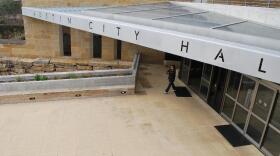Update: The Austin City Council approved the teleconferencing item on consent. The pilot program will begin in District 6 and will ultimately expand to all Austin City Council districts.
Original post: In a quest to simplify the lives of some constituents, while easing some downtown traffic, Austin City Council Member Don Zimmerman has proposed testing out videoconferencing for some citizen communication.
“I have a lot of constituents complaining about parking problems and just the delays trying to get down to testify,” said Zimmerman, who represents District 6, one of the city’s ten districts farthest from Austin City Hall. “They could easily be looking at two-and-a-half hours out of their day to get three minutes to say something in front of council.”
The suggested pilot program would allow Zimmerman’s constituents to testify from his field office during the council’s noon public comment slot – a staple of every Thursday meeting. Zimmerman has gathered support from across the dais, including the mayor and Council Member Ora Houston. But the pilot program would focus on Zimmerman’s district, since he is the only Council member with a local office.
Bennett Sandlin, executive director of the Texas Municipal League, said the state law that made this possible was mostly focused on allowing council members to videoconference in to meetings. While a League City, Texas spokesperson confirmed that council members for the city in the Houston metro area have used videoconferencing to participate in meetings while out of town, neither Sandlin nor the spokesperson could name another Texas city that had used it – either for council members or members of the public.
Sandlin suggested potential technological issues made the whole too cumbersome.
“You’ve got to be able to be seen and see and take comments from the public – all that over video in presumably different peoples’ houses or wherever they’re set up,” he said. “It’s just too much hassle.”
But Council Member Ellen Troxclair’s office said that she has considered attending council meetings by video while on a forthcoming maternity leave.
When it comes to citizens availing themselves of the technology, though, Sandlin said he thought for some, a physical presence makes a difference.
“There’s something kind of, I guess, impersonal about video,” he said.
Retired local activist David King agreed.
“The body language, the intonations of your voice, it seems to come through better if you’re there physically in person,” said King. While King said he will support the measure – noting how it opens access to residents who may not have the means (be it time or money) to come to City Hall – he doesn’t see himself using it.
“I think you get the full impact when you’re there in person.”






